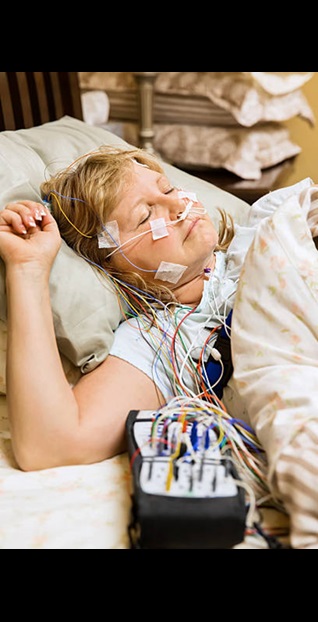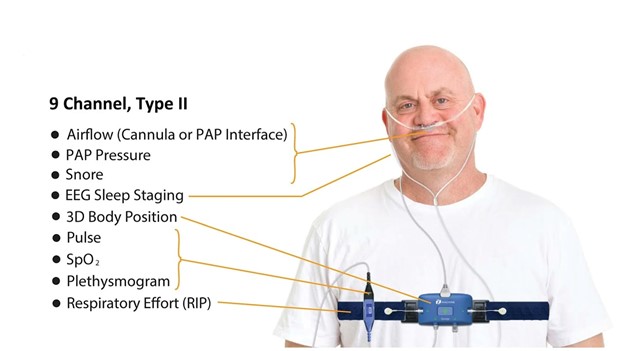If your AME has required you to have a sleep study, the FAA has specified two options for diagnostic testing:
If it is determined that a sleep study is necessary, it must be either a Type I laboratory polysomnography or a Type II (7 channel) unattended home sleep test (HST) that provides comparable data and standards to laboratory diagnostic testing.*
This article will explain the differences between these two types of sleep studies so you can make an informed choice.
1. Type I laboratory polysomnography; i.e., an in-lab sleep study
Description:
You will need to spend a full night in a sleep laboratory. A sleep technologist will “hook you up,” i.e., prepare you for the study, by attaching a number of sensors to your body. The technologist will use an abrasive paste to prepare areas on your scalp for EEG (brain wave) electrodes that will allow the doctor to determine whether you’re awake or asleep and, if asleep, what stage of sleep you’re in. Sensors applied by your eyes will help determine when you’re in rapid eye movement (REM) sleep. There will also be a sensor on your chin. Several EKG leads will be applied to your chest and other sensors will be applied to your legs. You will wear two stretchy belts, one around your chest and another around your abdomen. There will be an oxygen monitor probe on one finger. Lastly, you will wear a nasal cannula and “thermistor” in your nose that measure air flow. An infrared camera records your body movements and behaviors. A technologist will be monitoring you throughout the night. The photo below shows what a typical in-lab sleep study involves:

Pros:
- This type of sleep study has historically been considered the gold standard in diagnosing sleep disorders such as sleep apnea.
- It is a highly controlled environment. If a critical sensor falls off, the technologist will be able to identify the problem and fix the connection.
Cons:
- A full night in the sleep lab is required. There are a number of factors that make it hard for many patients to get a “typical” night’s sleep, including:
- Sleeping in a foreign environment
- The number of sensors on your body
- Typical “lights out” start time and “lights on” (end time) of the study are usually quite early and out of sync with many people’s sleep schedules. A typical lights-out time is around 10 p.m. with a lights-on time of 5 a.m. Many people find it hard to fall asleep that early
- Rarely, such little sleep data is gained that the patient has to repeat the study.
- Another issue is wait time. If you are required to have a sleep study, you have 90 days to satisfy the FAA’s requirements or be grounded. This includes meeting with a sleep doctor to certify that you are effectively treated should you test positive for sleep apnea. Depending on where you are in the country, the wait time for an in-lab sleep study can be weeks to months. COVID protocols and staffing issues have reduced the capacity and efficiency of sleep centers.
- Finally, in-lab sleep studies can be quite expensive. They are often covered in part or in full by insurance, but if you have a higher deductible plan or do not have health care insurance, you might face a bill of $1,000–$4,000.
2. Type II unattended home sleep tests
Description:
A Type II home sleep study is self-administered and performed in your home. The most typical version of a Type II home sleep study involves the following sensors:
- Two or more electrodes applied to the scalp to measure brain waves
- A nasal cannula
- One belt over the chest area
- A pulse oximeter on your finger
Typically only one night of data is needed. The photo below depicts a typical Type II home sleep test setup:

Pros:
- Type II home sleep studies are more convenient than in-lab sleep studies. Generally they can be performed more quickly, although ship times (to the patient and back to the sleep clinic) need to be factored in.
- There is a strong argument that the data obtained in your typical sleep environment and in the setting of your usual habits is more valid than the data obtained in the sleep lab’s artificial environment.
- The cost of a Type II home sleep test will be significantly lower than an in-lab sleep study due to reduced labor costs and overhead of the sleep lab’s operations.
Cons:
- The biggest drawback for this type of study is the risk of user error or mechanical failure, which could lead to a failed study and having to repeat the test.
- There are currently a limited number of companies that offer Type II home sleep tests. Most companies that offer home sleep apnea tests utilize Type III or Type IV home sleep tests, which do not involve EEG monitoring and are easier to perform and interpret; however, they do not meet the FAA’s criteria for sleep apnea testing.
For further information see the FAA’s webpage on Decision Considerations Disease Protocols, Obstructive Sleep Apnea (OSA).
*FAA.gov, Obstructive Sleep Apnea Specification Sheet B Assessment Request
Dr. Joseph Krainin is the founder of Singular Sleep, the
first-ever completely virtual sleep center. He is double board-certified in
Neurology and Sleep Medicine and is based in the Jacksonville, FL area. Dr.
Krainin graduated from Tufts University School of Medicine and received his
Sleep Medicine training at the world-renowned Michal Aldrich Sleep Disorders
Center at the University of Michigan. He has been practicing medicine for
18 years and sleep apnea is his main area of interest. He is a sought-after
lecturer and media commentator and is considered to be a thought-leader in the
field of traumatic brain injury-related sleep disorders. Dr. Krainin has
cultivated a niche specialty in managing pilots with sleep apnea. He is married
and the father of three young children. He is not a pilot himself but has been
hang-gliding and skydiving before. He hopes to take a flying lesson
someday. Dr. Krainin is also a board-certified sleep physician and the Founder of Singular Sleep, a virtual sleep clinic that offers Type 2 home sleep tests.







